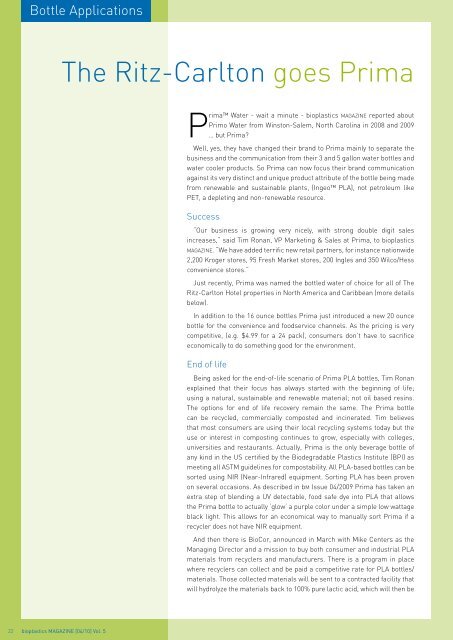04 | 2010
You also want an ePaper? Increase the reach of your titles
YUMPU automatically turns print PDFs into web optimized ePapers that Google loves.
Bottle Applications<br />
The Ritz-Carlton goes Prima<br />
Prima Water - wait a minute - bioplastics MAGAZINE reported about<br />
Primo Water from Winston-Salem, North Carolina in 2008 and 2009<br />
… but Prima?<br />
Well, yes, they have changed their brand to Prima mainly to separate the<br />
business and the communication from their 3 and 5 gallon water bottles and<br />
water cooler products. So Prima can now focus their brand communication<br />
against its very distinct and unique product attribute of the bottle being made<br />
from renewable and sustainable plants, (Ingeo PLA), not petroleum like<br />
PET, a depleting and non-renewable resource.<br />
Success<br />
“Our business is growing very nicely, with strong double digit sales<br />
increases,“ said Tim Ronan, VP Marketing & Sales at Prima, to bioplastics<br />
MAGAZINE. “We have added terrific new retail partners, for instance nationwide<br />
2,200 Kroger stores, 95 Fresh Market stores, 200 Ingles and 350 Wilco/Hess<br />
convenience stores.“<br />
Just recently, Prima was named the bottled water of choice for all of The<br />
Ritz-Carlton Hotel properties in North America and Caribbean (more details<br />
below).<br />
In addition to the 16 ounce bottles Prima just introduced a new 20 ounce<br />
bottle for the convenience and foodservice channels. As the pricing is very<br />
competitive, (e.g. $4.99 for a 24 pack), consumers don’t have to sacrifice<br />
economically to do something good for the environment.<br />
End of life<br />
Being asked for the end-of-life scenario of Prima PLA bottles, Tim Ronan<br />
explained that their focus has always started with the beginning of life;<br />
using a natural, sustainable and renewable material; not oil based resins.<br />
The options for end of life recovery remain the same. The Prima bottle<br />
can be recycled, commercially composted and incinerated. Tim believes<br />
that most consumers are using their local recycling systems today but the<br />
use or interest in composting continues to grow, especially with colleges,<br />
universities and restaurants. Actually, Prima is the only beverage bottle of<br />
any kind in the US certified by the Biodegradable Plastics Institute (BPI) as<br />
meeting all ASTM guidelines for compostability. All PLA-based bottles can be<br />
sorted using NIR (Near-Infrared) equipment. Sorting PLA has been proven<br />
on several occasions. As described in bM Issue <strong>04</strong>/2009 Prima has taken an<br />
extra step of blending a UV detectable, food safe dye into PLA that allows<br />
the Prima bottle to actually ‘glow‘ a purple color under a simple low wattage<br />
black light. This allows for an economical way to manually sort Prima if a<br />
recycler does not have NIR equipment.<br />
And then there is BioCor, announced in March with Mike Centers as the<br />
Managing Director and a mission to buy both consumer and industrial PLA<br />
materials from recyclers and manufacturers. There is a program in place<br />
where recyclers can collect and be paid a competitive rate for PLA bottles/<br />
materials. Those collected materials will be sent to a contracted facility that<br />
will hydrolyze the materials back to 100% pure lactic acid, which will then be<br />
22 bioplastics MAGAZINE [<strong>04</strong>/10] Vol. 5


















